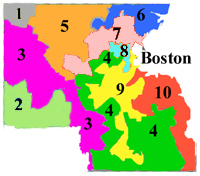| Massachusetts' Political Lineup
|
Redistricting Deadline There is no deadline for congressional redistricting, although the state legislative districts must be drawn in time for the 2002 election. | Who’s in Charge of Redistricting? The state legislature is responsible for drawing both the congressional and state legislative district lines. The governor has veto power over both plans. | ||||||||||||||||||||||||
Districting Principles
| Public Access There are public hearings around the state. There has been no final decision on what will be available on the Internet, but proposed plans will likely be made available on a website. | ||||||||||||||||||||||||
Political Landscape In the 1991-92 redistricting cycle, the process was very partisan, with the state losing one House seat and a Democratic-dominated legislature pitted against a Republican governor. The redistricting process resulted in some particularly creative cartography that had nothing to do with representation of racial minorities and everything to do with political considerations. Redistricting promises to be a partisan battle again in 2001-2, with the heavily Democratic legislature again facing a Republican governor. Currently nineDemocrats and no Republicans represent Massachusetts in the U.S. House; a vacancy is certain to be filled by a Democrat. Earlier in the decade, two Republicans held seats, but lost to Democratic challengers amidst a significant shift toward Massachusetts Democrats in federal elections in 1996, 1998 and 2000.
| Legal Issues The state of Massachusetts sued the U.S. Secretary of Commerce in 1991 when it lost a congressional seat after the 1990 census. Massachusetts objected to the census bureau's allocation of overseas military personnel into state-by-state population counts based on their usual residence -- an allocation method that directly contributed to the state losing a House seat. Massachusetts won in U.S. district court but the United States Supreme Court overturned, noting that Massachusetts sued under the Administrative Procedure Act, which requires a "final agency action." The Census Bureau’s report was not final however, since the President was able to adopt or revise the Bureau's population report as he saw fit. Thus, the court found that the claim was not subject to the act. The court also found the Bureau's allocation method an acceptable strategy for promoting equality of representation among the states. A challenge was also directed at Massachusetts' practice of delaying state legislative redistricting until five years after the decennial census. In the past, a separate state census was conducted in that fifth year to be used for state and local electoral boundaries. The state census was abolished in 1990 but the date for state redistricting remained the same. A state court upheld the late state legislative redistricting and explained that the purpose of the late redistricting was to legitimately facilitate the transitional difficulties that will be faced when using the federal census for the first time in 1995. |
Contact Information William P. Murray Senator Stan Rosenberg |


